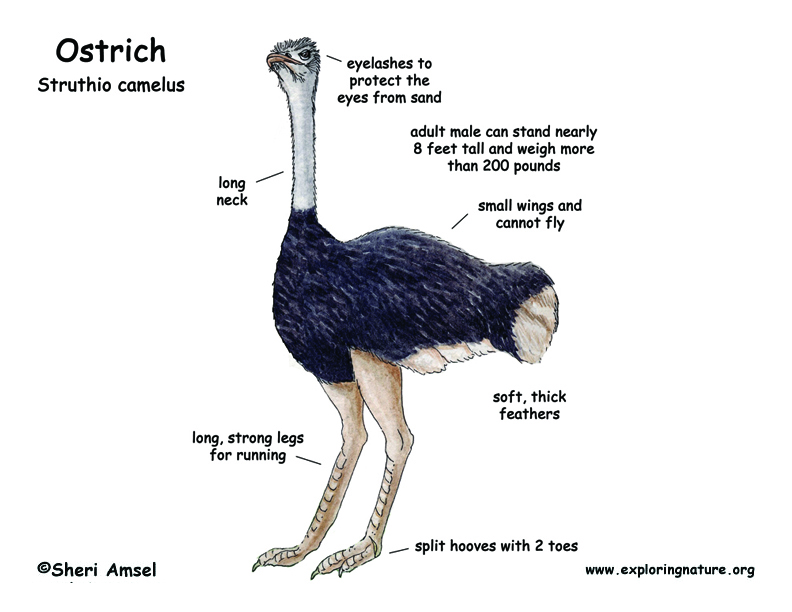

They are found in East and South Africa.
They live on the dry grassland savannahs and in some areas of the Sahara desert.
The ostrich is the largest living bird. An adult male can stand nearly 8 feet tall and weigh more than 200 pounds! They have small wings and cannot fly, but have split hooves with 2 toes and long, strong legs for running. They have soft, thick feathers that protect them from the heat of their habitat and thick eyelashes to protect their eyes from sand storms. They also have great eyesight and hearing to watch for predators.
Many of the animals grazing on the grasslands depend on the ostrich to let them know when predators are near. They run very fast from predators but also can run a long ways to look for food and water. If attacked, an ostrich has a powerful kick with which to defend itself. They can live from 30 – 70 years!
Ostriches eat seeds, grass, leaves, and bushes. They sometimes eat insects and lizards too.
The male ostrich has a group (harem) of 3 - 5 females, who all lay their eggs in the same nest for about 3 weeks (polygamous) right before the rainy season. He makes the nest, which is just a dent scratched in the ground that holds up to 25 big, white, round eggs. Only about half the eggs will make it to hatching, because of predators. The males warm (incubates) the eggs at night.
Kingdom: Animalia
Phylum: Chordata
Subphylum: Vetebrata
Class: Aves
Order: Struthioniformes
Family: Struthionidae
Genus: Struthio
Species: S. camelus
When you research information you must cite the reference. Citing for websites is different from citing from books, magazines and periodicals. The style of citing shown here is from the MLA Style Citations (Modern Language Association).
When citing a WEBSITE the general format is as follows.
Author Last Name, First Name(s). "Title: Subtitle of Part of Web Page, if appropriate." Title: Subtitle: Section of Page if appropriate. Sponsoring/Publishing Agency, If Given. Additional significant descriptive information. Date of Electronic Publication or other Date, such as Last Updated. Day Month Year of access < URL >.
Amsel, Sheri. "Ostrich" Exploring Nature Educational Resource ©2005-2024. December 13, 2024
< http://www.exploringnature.org/db/view/Ostrich >


